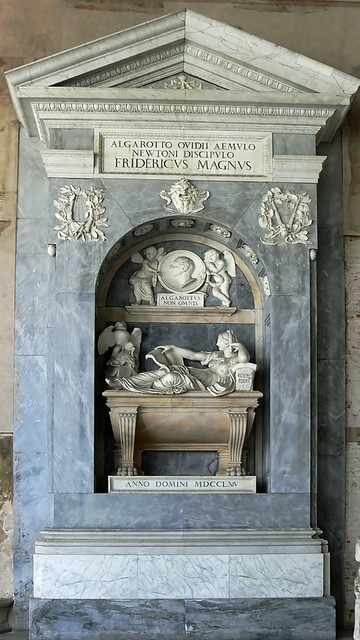Tomb of Algarotti Ovidio Arminio - Camposanto Monumentale, Pisa

This elaborate Baroque tomb, located in the portico of the Camposanto Monumentale, commemorates Algarotti Ovidio Arminio, a disciple of Sir Isaac Newton, and is dated to the year 1765 (as inscribed). Crafted from white and gray marble, the monument was likely designed by a prominent 18th-century sculptor, possibly influenced by the works of Giovanni Battista Foggini or other Tuscan Baroque masters, and reflects the intellectual and artistic currents of the Enlightenment. The tomb honors Algarotti, a notable figure in the dissemination of Newtonian science in Italy, and its design blends classical architecture with allegorical elements.
he tomb is a tall, rectangular aedicule (small shrine-like structure), approximately 3 meters high and 1.5 meters wide, featuring a pedimented top supported by pilasters with Corinthian capitals. The pediment is adorned with a frieze of dentil molding and decorative urns at the corners, while the entablature bears the inscription "ALGAROTTO OVIDII ARMILIO NEWTONI DISCIPULO FRIDERICVS MAGNVS", translating to "To Algarotti, Ovidio Arminio, disciple of Newton, Frederick the Great [erected this]." This suggests patronage by Frederick II of Prussia, who admired Algarotti's contributions to science and culture. The lower section includes a stepped base with a panel inscribed "ANNO DOMINI MDCCLXV" (1765), marking the year of erection or death. The marble shows signs of age, with some discoloration and minor cracks, reflecting its historical endurance.
Within a recessed arched niche, the focal point is a reclining male effigy, presumably Algarotti, depicted in a serene pose atop a sarcophagus. He lies on his side, propped on one elbow, with a book or scroll in hand—symbolizing his scholarly legacy—while his other arm rests gently across his chest. His attire, a classical toga or robe, flows naturally over his form, carved with soft folds that suggest repose rather than rigidity. His face, though weathered, conveys a contemplative expression, aligning with his intellectual stature.
Flanking the effigy are two winged genii (putti or allegorical figures), rendered in high relief. One genius, positioned to the left, holds a laurel wreath above Algarotti's head, symbolizing victory and eternal fame, while the other, to the right, appears to adjust a curtain or drapery, adding a theatrical flourish. Their youthful forms and dynamic poses, with fluttering wings and flowing garments, evoke Baroque movement and lightness, contrasting with the static dignity of the central figure. Above the niche, a circular medallion with a profile relief—possibly of Frederick the Great or Algarotti himself—is framed by additional putti, reinforcing the monument's grandeur.
This tomb reflects the Baroque style's dramatic flair, adapted to honor a scientific luminary, blending classical motifs with the era's reverence for reason. Algarotti (1712–1764), a Venetian polymath known for Il Newtonianismo per le dame (1737), popularized Newton's optics and gravitation theories across Europe, earning Frederick the Great's patronage during his Berlin years (1740s–1750s). The tomb's erection in 1765, shortly after his death, suggests a posthumous tribute, possibly funded by Frederick or Italian admirers.
